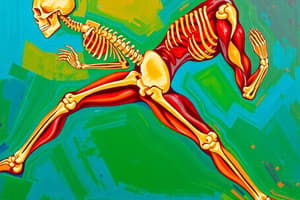Podcast
Questions and Answers
What type of movement occurs at the radio-ulnar joint when the forearm turns palm down?
What type of movement occurs at the radio-ulnar joint when the forearm turns palm down?
- Circumduction
- Dorsiflexion
- Supination
- Pronation (correct)
Which muscle group acts as prime movers when extending the arm at the elbow joint?
Which muscle group acts as prime movers when extending the arm at the elbow joint?
- Triceps (correct)
- Quadriceps
- Hamstrings
- Biceps
What happens during dorsiflexion of the ankle joint?
What happens during dorsiflexion of the ankle joint?
- The foot moves towards the shin (correct)
- The foot rotates internally
- The foot remains stationary
- The foot moves away from the shin
Which of the following movements is classified as lateral flexion?
Which of the following movements is classified as lateral flexion?
Which statement about agonist muscles is true?
Which statement about agonist muscles is true?
What is the primary function of the skeletal system?
What is the primary function of the skeletal system?
Which type of joint movement involves a body part moving towards the midline of the body?
Which type of joint movement involves a body part moving towards the midline of the body?
During which type of movement does a joint describe a cone shape?
During which type of movement does a joint describe a cone shape?
What does the structure of a synovial joint primarily allow?
What does the structure of a synovial joint primarily allow?
Flexion of a joint positions a body part in what direction?
Flexion of a joint positions a body part in what direction?
What connective tissue primarily makes up bone?
What connective tissue primarily makes up bone?
Which activity occurs during horizontal flexion at the shoulder joint?
Which activity occurs during horizontal flexion at the shoulder joint?
What are the two main types of the skeletal system?
What are the two main types of the skeletal system?
Flashcards are hidden until you start studying
Study Notes
Musculo-Skeletal System Overview
- The skeletal system provides body shape, protection for internal organs, and a framework for muscle attachment facilitating movement.
- Comprised of two primary types: appendicular (extremities) and axial (skull, ribcage, vertebral column).
Bones and Cartilage
- Bone structure consists of collagen fibers infused with minerals, primarily calcium salts.
Joints
- Joints connect bones, enabling movement and stabilization.
- Movement is facilitated by the contraction of skeletal muscles across joints, typically with two attachment points on opposite sides.
Movements of Synovial Joints
- Flexion and Extension: Flexion moves a body part forward; extension moves it backward.
- Horizontal Flexion and Extension: Horizontal flexion brings the arm closer to the body; horizontal extension moves the arm away from the body.
- Abduction and Adduction: Abduction moves a body part away from the midline; adduction draws it toward the midline.
- Rotation: Involves turning a body part around its long axis.
- Circumduction: A conical movement where the end of a body part moves in a circular pattern.
- Pronation and Supination: Specific to the forearm; supination occurs in the anatomical position, while pronation refers to rotation inward.
- Lateral Flexion: Bending of the spine sideways, unique to spinal movement.
- Dorsiflexion and Plantar Flexion: Dorsiflexion brings the foot towards the shin; plantar flexion moves the foot away from the shin.
Joint Types and Movements
- Left shoulder: Ball & socket, capable of flexion.
- Right wrist: Condyloid joint, capable of extension.
- Right knee: Hinge joint, allows for extension.
Muscular System Overview
- Muscles are responsible for pulling bones to produce movement, working in pairs to create movement and return to original positions.
- Antagonistic Muscle Action: One muscle contracts (agonist) while its counterpart (antagonist) lengthens to stabilize and facilitate movement.
Muscle Types
-
Agonist Muscles:
- Prime movers (e.g., biceps, hamstrings).
- Contract to produce movement by pulling and shortening during actions.
-
Antagonist Muscles:
- Perform the opposite action of agonists (e.g., triceps to biceps).
- Stabilize movement by lengthening when agonists contract.
Rotator Cuff Muscles
- Key muscles include infraspinatus and subscapularis, crucial for shoulder stabilization and movement.
Studying That Suits You
Use AI to generate personalized quizzes and flashcards to suit your learning preferences.




